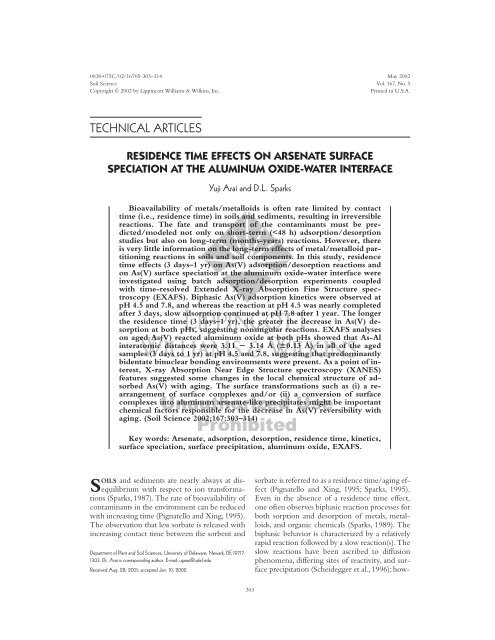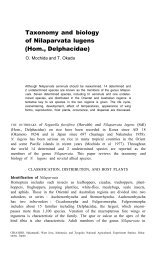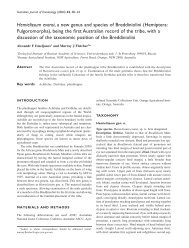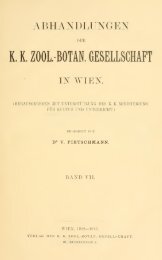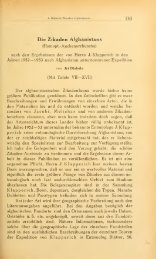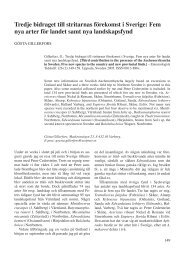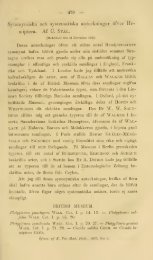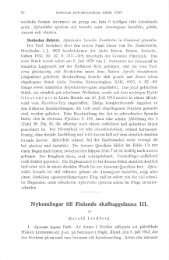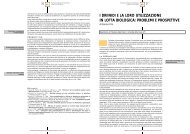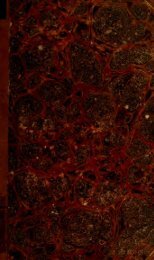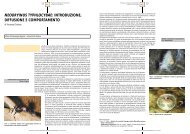technical articles - College of Agriculture & Natural Resources ...
technical articles - College of Agriculture & Natural Resources ...
technical articles - College of Agriculture & Natural Resources ...
Create successful ePaper yourself
Turn your PDF publications into a flip-book with our unique Google optimized e-Paper software.
0038-075C/02/16705-303–314 May 2002<br />
Soil Science Vol. 167, No. 5<br />
Copyright © 2002 by Lippincott Williams & Wilkins, Inc.<br />
Printed in U.S.A.<br />
TECHNICAL ARTICLES<br />
RESIDENCE TIME EFFECTS ON ARSENATE SURFACE<br />
SPECIATION AT THE ALUMINUM OXIDE-WATER INTERFACE<br />
Yuji Arai and D.L. Sparks<br />
Bioavailability <strong>of</strong> metals/metalloids is <strong>of</strong>ten rate limited by contact<br />
time (i.e., residence time) in soils and sediments, resulting in irreversible<br />
reactions. The fate and transport <strong>of</strong> the contaminants must be predicted/modeled<br />
not only on short-term (
304 ARAI AND SPARKS SOIL SCIENCE<br />
ever, without molecular scale investigations, the<br />
mechanism for sorption/desorption reactions cannot<br />
be verified.<br />
Several in situ spectroscopic studies (Extended<br />
X-ray Absorption Fine Structure spectroscopy<br />
(EXAFS), Attenuated total reflectance Fourier<br />
Transform infrared (ATR-FTIR) spectroscopy,<br />
and Raman spectroscopy) have shown different<br />
metal/metalloid chemical speciation at metal oxide/phyllosilicate-water<br />
interfaces. The formation<br />
<strong>of</strong> outer-sphere selenate complexes (Hayes<br />
et al.,1987),a mixture <strong>of</strong> inner-sphere and outersphere<br />
As(III), Co(II), and Pb(II) complexes (Arai<br />
et al.,2001;Papelis and Hayes,1996;Strawn et al.,<br />
1998), inner-sphere As(III and V), Cu(II), Pb(II),<br />
and Zn(II) surface complexes (Arai et al., 2001;<br />
Bargar et al., 1997; Cheah et al., 1998; Fendorf et<br />
al., 1997; Goldberg and Johnston, 2001; O’Reilly<br />
et al., 2001; Waychunas et al., 1993), and mixed<br />
metal (Ni(II) and Zn(II))-aluminum surface precipitates<br />
(Ford and Sparks, 2000; Scheidegger et<br />
al., 1997) have been determined. However, although<br />
many spectroscopic studies have provided<br />
important information on chemical speciation<br />
for reaction processes <strong>of</strong> more than 48 hours, the<br />
mechanisms for longer reaction times (days to<br />
months) have not been investigated extensively.<br />
Changes in the surface speciation <strong>of</strong> Co(II)/<br />
Ni(II)-Al surface precipitates on kaolinite and<br />
pyrophyllite were reported for 1 to several<br />
month(s) <strong>of</strong> reaction time (Ford et al., 1999;<br />
O’Day et al., 1994; Scheckel et al., 2000; Thompson<br />
et al.,1999).Some researchers have shown that<br />
metals/metalloids (i.e., As(V), Ni(II), and Pb(II))<br />
reacted with metal oxides and pyrophyllite over<br />
longer times resulted in either irreversible or reversible<br />
retention mechanisms (Ford et al., 1999;<br />
O’Reilly et al., 2001; Strawn et al., 1998). For example,with<br />
1 year aged Ni(II) reacted pyrophyllite,<br />
there was little Ni(II) release by HNO 3<br />
and EDTA<br />
(Ford et al., 1999; Scheckel et al., 2000). Conversely,<br />
O’Reilly et al. (2001) found that 200 days<br />
aging time did not cause a decrease in As(V) release<br />
from aged As(V) reacted goethite samples when<br />
phosphate was the desorbing ligand (O’Reilly et<br />
al., 2001). Accordingly, long-term metal/metalloid<br />
ion partitioning reactions can/cannot become significant<br />
factors in controlling the contaminant<br />
bioavailability in soils and sediments.<br />
In this study, we investigated the effect <strong>of</strong> residence<br />
time (3 days to 1 yr) on As(V) surface speciation<br />
at the aluminum-oxide water interface. To<br />
understand better the chemical processes responsible<br />
for the residence time effect, macroscopic<br />
batch adsorption/desorption experiments were<br />
coupled with molecular scale time-resolved<br />
EXAFS analysis. Arsenate, derived from indigenous<br />
sources and anthropogenic inputs, was chosen<br />
as the adsorbate because it is a toxic metalloid<br />
in oxic terrestrial water environments The impact<br />
<strong>of</strong> As on human/ecological health is cause for<br />
great concern in the United States (Allen et al.,<br />
1995). Interest in As has recently been heightened<br />
by the controversy over setting the maximum<br />
concentration level <strong>of</strong> As in drinking water,which<br />
was recently set at 10 ppb (USEPA, 2001). Aluminum<br />
oxide was chosen as an adsorbent because<br />
(i) it is a common soil mineral that has high adsorption<br />
capacity for various oxyanions (e.g.,arsenate)<br />
and (ii) it is a potential adsorbent (e.g., activated<br />
alumina) for As at water treatment plants.<br />
MATERIALS AND METHODS<br />
Materials<br />
The -Al 2<br />
O 3<br />
(Degussa Inc.,Akron, OH) was<br />
chosen as an adsorbate because well hydrated -<br />
Al 2<br />
O 3<br />
(bayerite polymorph) contains aluminum<br />
octahedral sheets similar to aluminum oxides in<br />
soils (e.g., gibbsite) (Dyer et al., 1993;Wijnja and<br />
Schulthess, 1999). Total ignition and transmission<br />
electron microscopic analyses showed greater<br />
than 99.6% purity and an average particle radius<br />
<strong>of</strong> 13 nm (Degussa Inc., Akron, OH). The 5-<br />
point Brunauer-Emmett-Teller surface area was<br />
90.1 ( 0.2) m 2 g 1 . The isoelectric point was<br />
9.3 ( 0.1), as determined by electrophoretic<br />
mobility measurements (Arai et al., 2001). ACS<br />
grade sodium arsenate,Na 2<br />
HAsO 4<br />
•7H 2<br />
O (Baker)<br />
and NaCl (Fisher) were used as reagent sources.<br />
A mansfieldite (Al 2<br />
O 3<br />
•AsO 5<br />
•4H 2<br />
O, South Bedford<br />
mining, Gawton, near River Tamar, England)<br />
was used in the EXAFS analyses to extract<br />
theoretical phases-shift and amplitude reduction<br />
factors using the structural refinement data<br />
and the ab initio computer code FEFF702. The<br />
mansfieldite contains a corner-sharing threedimensional<br />
network <strong>of</strong> cis-AlO 4<br />
•2H 2<br />
O octahedra<br />
and AsO 4<br />
tetrahedra strucures similar to other<br />
members <strong>of</strong> the variscite group such as scorodite<br />
(FeAsO 4<br />
•2H 2<br />
O).<br />
Methods<br />
Batch Adsorption Experiments<br />
The adsorption kinetic experiments were<br />
performed in two steps. First, the -Al 2 O 3 suspension<br />
(5g L 1 ) was hydrated in 200 mL <strong>of</strong><br />
0.1M NaCl background electrolyte solutions for<br />
approximately 1 month. This hydration time was<br />
employed to assure the transformation <strong>of</strong> -
VOL. 167 ~ NO. 5 ARSENATE SURFACE SPECIATION 305<br />
Al 2 O 3 into a bayerite polymorph, hereafter referred<br />
to as aluminum oxide (Dyer et al., 1993;<br />
Wijnja and Schulthess, 1999). Second, the pH <strong>of</strong><br />
the mineral suspensions was adjusted to pH 4.5<br />
and 7.8 for 24 h using a stirred pH-stat apparatus,<br />
and these pHs were maintained during the first<br />
48 h <strong>of</strong> the kinetic experiments as described below.<br />
The MINEQL chemical speciation program<br />
predicted that the experimental systems<br />
were undersaturated with respect to boehmite,<br />
gibbsite, and amorphous Al 2 O 3 during hydration<br />
and pH adjustments. Fifty milliliters <strong>of</strong> a 5 mM<br />
sodium arsenate stock solution (5 mM sodium arsenate<br />
and 0.1 M NaCl) were added slowly (10<br />
mL additions every 30 s) to assure an initial As(V)<br />
concentration <strong>of</strong> 1 mM. The mineral suspensions<br />
were stirred at 300 r.p.m. at 298 K. Samples (10<br />
mL) <strong>of</strong> the mineral suspensions were taken periodically<br />
(at 5,15,and 30 min and 1,2,4,6,12,and<br />
24 h) and then passed through a 0.2-m Gelman<br />
Supor®-200 membrane filter (Pall Corp.,Ann Arbor,<br />
MI). The filtrates were analyzed for total As<br />
and Al by ICP-AES and or dissolved As(V) by the<br />
colorimetric method described by Cummings et<br />
al. (Cummings et al., 1999).After 48 h <strong>of</strong> reaction<br />
using the pH-stat apparatus, the reaction vessels<br />
were placed on an orbital shaker and shaken continuously<br />
at 300 r.p.m. for up to 12 months. pH<br />
was adjusted manually every 15 to 30 days with<br />
the addition <strong>of</strong> 0.1 M HCl or 0.1 M NaOH over<br />
the adsorption reaction period <strong>of</strong> 48 hours to 12<br />
months.As(V) uptake from the bulk solution was<br />
monitored continuously at 5 and 15 days and 1,<br />
4.5, 7, and 12 months. Total As in the filtrate was<br />
analyzed using the methods described above.<br />
Batch Desorption Experiments<br />
Arsenate reversibility from aged (3 days and 1,<br />
4.5, and 12 months) As(V) reacted aluminum oxide<br />
samples at pH 4.5 and 7.8 was investigated using<br />
a replenishment technique.The replenishment<br />
method was chosen over a flow-method (e.g.,miscible<br />
displacement and stirred flow methods) because<br />
the fine particle size <strong>of</strong> the -Al 2<br />
O 3<br />
(average<br />
particle radius <strong>of</strong> 13 nm,Degussa Inc.,Akron,OH)<br />
caused clogging <strong>of</strong> the filter when flow-methods<br />
were used. The aged samples were prepared according<br />
to the method described in the previous<br />
section.Thirty milliliters <strong>of</strong> duplicate aged suspensions<br />
were transferred into 50 mL polycarbonate<br />
high-speed centrifuge tubes and were centrifuged<br />
at 11,950 g for 10 min. The supernatant was decanted<br />
to recover the paste. The samples were resuspended<br />
in 30 mL <strong>of</strong> desorption solutions containing<br />
0.096 M NaCl, 1 mM sodium sulfate, and<br />
2 mM organic buffer (sodium acetate (Na-Ac) or<br />
4-(2-hydroxyethyl)-1-piperazine-ethanesulfonic<br />
acid (HEPS). The organic buffers Na-Ac and<br />
HEPS were used to maintain pH (i.e., 4.5 and 7.8<br />
0.2, respectively) during the desorption experiments.<br />
Tubes were shaken at 300 r.p.m. at 298 K<br />
for 24 h. The suspensions were then centrifuged,<br />
and the supernatant was analyzed for As(V) using<br />
the methods described in the adsorption kinetics<br />
section. The replenishment procedure was repeated<br />
25 times (i.e., 25 days).<br />
Arsenic K Edge EXAFS Analysis<br />
XAS samples (3 days and 4, 7, and 11 months<br />
at pH 4.5 and 3 days and 1, 8, and 12 months at<br />
pH 7.8) were prepared according to the methods<br />
described in the adsorption kinetics section above.<br />
Paste samples were recovered by centrifuging 30<br />
mL <strong>of</strong> As(V) reacted aluminum oxide suspensions<br />
in 50 mL polycarbonate high-speed centrifuge<br />
tubes at 11,950 g for 10 min, and the supernatant<br />
was decanted. All paste samples were loaded on<br />
openings (70 mm 250 mm) <strong>of</strong> Teflon sample<br />
holders (250 mm 400 mm), and the openings<br />
were sealed with a Type K-104 Kapton tape<br />
(E.I. Dupont, Wilmington, DE). Arsenic K-edge<br />
(11867 eV) XAS spectra were collected on beamline<br />
X-11A at the National Synchrotron Light<br />
Source (NSLS), Brookhaven National Laboratory,<br />
Upton, New York. The electron storage<br />
ring was operated at 2.528 GeV with a current<br />
range <strong>of</strong> 130 to 300 mA. The XAS spectra were<br />
collected in fluorescence mode with a Lytle detector<br />
filled with krypton gas. The ionization<br />
chamber (I o<br />
) was filled with 90% N 2<br />
and 10% Ar.<br />
As an internal standard, the arsenic K-edge <strong>of</strong><br />
sodium arsenate salt (1% by weight in boron nitride)<br />
was run simultaneously with adsorption<br />
samples to check for potential energy shifts during<br />
the run.A Ge-filter was used to remove elastically<br />
scattered radiation from the fluorescence<br />
emissions. The monochromator consisted <strong>of</strong> two<br />
parallel Si(111) crystals with a vertical entrance<br />
slit <strong>of</strong> 0.5 mm. The Teflon sample holder was<br />
oriented at 45 to the unfocused incident beam.<br />
All samples were scanned at 298 K. A total <strong>of</strong><br />
three to four spectra were collected for the adsorption<br />
samples,and one spectrum was collected<br />
for reference minerals such as mansfieldite, which<br />
was diluted to 1% by weight in ACS grade boron<br />
nitride for the XAS measurements.<br />
XAS data reduction and analysis were performed<br />
using WinXas 2.0 (Ressler, 1997) using<br />
the following procedures. First, three spectra per<br />
sample were averaged. The averaged spectra were
306 ARAI AND SPARKS SOIL SCIENCE<br />
normalized with respect to E o determined from<br />
the second derivative <strong>of</strong> the raw spectra, and the<br />
total atomic cross sectional absorption was then<br />
set to unity. A low-order polynomial function<br />
was fit to the pre-edge region and the postedge<br />
region. Next, the data were converted from E-<br />
space to k-space and weighted by k 3 to compensate<br />
for dampening <strong>of</strong> the XAFS amplitude with<br />
increasing k space. Fourier transformation was<br />
then performed over the k-space range <strong>of</strong> 1.8 to<br />
11.6 Å 1 to obtain the radial structural functions<br />
(RSF). Final fitting <strong>of</strong> the spectra was done on<br />
Fourier transformed k 3 weighted spectra in R-<br />
space. The FEFF702 code reference (Zabinsky et<br />
al., 1995) was utilized to calculate single scattering<br />
theoretical spectra and phase shifts for As-O<br />
and As-Al backscatters using an input file based<br />
on the structural refinement <strong>of</strong> mansfieldite<br />
(AlAsO 4<br />
• 2H 2<br />
O). During fitting, the values <strong>of</strong> N<br />
and R <strong>of</strong> the As-O and As-Al shells were allowed<br />
to vary, as was a single E 0<br />
for all sets <strong>of</strong> backscattering<br />
atoms. The Debye-Waller factors <strong>of</strong> the<br />
As-O shells were also allowed to vary, but those<br />
<strong>of</strong> the As-Al shells were fixed at 0.006 Å 2 .When<br />
allowed to vary, the Debeye-Waller factors <strong>of</strong> the<br />
As-Al shells showed no trends for different aged<br />
samples, and we therefore used the average values<br />
(i.e., 0.006 Å 2 ) in the final fitting procedure to<br />
reduce the number <strong>of</strong> free parameters.<br />
Fig. 1. Arsenate adsorption kinetics at the aluminum<br />
oxide-water interface at pH 4.5 and 7.8.<br />
RESULTS AND DISCUSSION<br />
Arsenate Adsorption Kinetics<br />
Arsenate adsorption kinetics at the aluminum<br />
oxide-water interface at pH 4.5 and 7.8 are<br />
shown in Fig. 1. The initial fast adsorption was<br />
followed by a continuous slow adsorption with<br />
increasing time at both pHs.A similar biphasic reaction<br />
phenomenon has been well documented<br />
for tetrahedral oxyanion (i.e.,phosphate and arsenate)<br />
reactions on soils and soil components (i.e.,<br />
amorphous Al(OH) 3 , natural allophane, ferrihydrite,<br />
hematite, goethite, -Al 2 O 3 , and kaolinite)<br />
over different time scales (hours to months) (Anderson<br />
et al., 1976; Barron and Torrent, 1995;<br />
Barrow, 1974; Barrow, 1985; Beek and van<br />
Riemsdijk, 1982; Black, 1942; Colemann, 1944;<br />
Edzwald et al., 1976; Fuller et al., 1993; Hingston<br />
et al., 1974; Hsu and Rennie, 1962; Kafkafi et al.,<br />
1967; Madrid and Posner, 1979; Okajima et al.,<br />
1983; O’Reilly et al., 2001; Parfitt, 1979; Parfitt,<br />
1989; Ryden et al., 1977; van Riemsdijk et al.,<br />
1977; Willett et al., 1988). Although As(V) adsorption<br />
at pH 4.5 was nearly completed after<br />
750 h, only 46% <strong>of</strong> total As(V) uptake was<br />
achieved at pH 7.8, and the reaction continued<br />
after 1 yr (8640 h).<br />
The difference in the kinetics at the two pHs<br />
could be explained by differences in the surface<br />
charge density <strong>of</strong> the aluminum oxide at the experimental<br />
pHs (4.5 and 7.8). The dissociation<br />
constants <strong>of</strong> H 3<br />
AsO 4<br />
(pK 1<br />
2.20, pK 2<br />
6.97, and<br />
pK 3<br />
13.4) indicate that the predominant As(V)<br />
solution speciation consisted <strong>of</strong> negatively charged<br />
species at our experimental pHs (i.e.,H 2<br />
AsO 4<br />
at<br />
pH 4.5 and HAsO 4<br />
2<br />
at pH 7.8) (Schecher and<br />
McAvoy,1998).The surface charge density <strong>of</strong> the<br />
aluminum oxide becomes more negatively charged<br />
with increasing pH bulk<br />
from 4.5 to the IEP <strong>of</strong> the<br />
solid (≈ 9.3) (Arai et al., 2001). Therefore, the<br />
mineral surface at pH 4.5 is more positively<br />
charged than at pH 7.8, and the protonated mineral<br />
surfaces at pH 4.5 may have a strong attraction<br />
for negatively charged As(V) solution species<br />
(e.g., H 2<br />
AsO 4<br />
). Our macroscopic evidence that<br />
negatively charged As solution species significantly<br />
sorbed onto positively charged aluminum<br />
oxide surfaces over time suggest possibilities for<br />
both electrostatic interaction and ligand exchange<br />
mechanisms. However, previous electrophoretic<br />
mobility measurements have shown that formation<br />
<strong>of</strong> As(V) inner-sphere surface complexes at<br />
the aluminum oxide-water interface are caused<br />
by shifts in the electrophoretic mobility <strong>of</strong> aluminum<br />
oxide p<strong>articles</strong> after As(V) adsorption<br />
(Arai et al., 2001; Suarez et al., 1999). In addition,<br />
our previous EXAFS study (Arai et al., 2001) and<br />
the in situ vibrational spectroscopic study <strong>of</strong> Goldberg<br />
and Johnston (2001) show that the formation<br />
<strong>of</strong> inner-sphere complexes via ligand exchange<br />
was predominantly responsible for As(V)<br />
adsorption (48 h) at the aluminum oxide-water<br />
interface.
VOL. 167 ~ NO. 5 ARSENATE SURFACE SPECIATION 307<br />
Differences in the initial (48 h) adsorption<br />
kinetics at pH 4.5 and 7.8 might be attributed<br />
largely to the charge property <strong>of</strong> the mineral surface<br />
and the adsorbate solution speciation discussed<br />
above. However, the chemical factors responsible<br />
for the slow As(V) adsorption kinetics<br />
after 48 h are difficult to determine if based on<br />
the macroscopic data alone because changes in<br />
the charge properties <strong>of</strong> the mineral surface, the<br />
surface area, and the aluminum oxide structure<br />
are probably occurring with aging. Therefore, we<br />
used the EXAFS technique to investigate the<br />
changes in As(V) surface speciation as a function<br />
<strong>of</strong> time. Additionally, the stability <strong>of</strong> aged As(V)<br />
reacted aluminum oxide was tested via batch desorption<br />
experiments to provide some insights on<br />
As bioavailability.<br />
Fig. 2. Residence time effects on As(V) desorption from<br />
aged As(V) reacted aluminum oxide at pH 4.5.<br />
Fig. 3. Residence time effects on As(V) desorption from<br />
aged As(V) reacted aluminum oxide at pH 7.8.<br />
Arsenate Desorption<br />
Figures 2 and 3 show total As(V) desorption<br />
from aged As(V) reacted aluminum oxide. Since<br />
the adsorption kinetics at pH 4.5 were much faster<br />
than at pH 7.8 (Fig. 1), the loading levels <strong>of</strong> the<br />
aged samples depended on pH and time (Table 1).<br />
Therefore,the amount <strong>of</strong> desorbed As(V) was normalized<br />
with respect to the initial loading levels in<br />
Fig. 2 and 3. Continuous As(V) release was observed<br />
in all samples at both pHs (Fig. 2 and 3),<br />
however the extent <strong>of</strong> As(V) desorption after 25<br />
replenishment cycles was different in each aged<br />
sample. At pH 4.5, total As(V) desorption decreased<br />
with increasing aging time from 3 days to<br />
1 year, suggesting a residence time effect (Fig. 2).<br />
The extent <strong>of</strong> As(V) release in 3 day and 1 month<br />
aged samples after 15 to 25 days <strong>of</strong> desorption was<br />
much greater than for 4.5 months to 1 year aged<br />
samples. Similar residence time effects (i.e., irreversibility)<br />
were also observed at pH 7.8 (Fig.3).In<br />
the 3 days and 1 month aged samples, total As(V)<br />
release was approximately 80 to 85% after 25 days<br />
<strong>of</strong> desorption; however, only 51 to 56% <strong>of</strong> As(V)<br />
was released from samples aged 4.5 months to 1<br />
year (Fig. 3). Overall, as aging time increased from<br />
3 days to 1 year, the relative amount <strong>of</strong> As(V) remaining<br />
on the mineral surface increased from<br />
23.46 to 54.81% at pH 4.5 and 15.43 to 48.9% at<br />
pH 7.8 (Table 1). Stabilization <strong>of</strong> adsorbed As(V)<br />
seems to have occurred after a residence <strong>of</strong> 4.5 m<br />
at both pHs. Similar research findings (i.e., irreversible<br />
As(V) desorption from soils and clay minerals)<br />
have been reported by several researchers.<br />
Woolson and co-workers investigated the aging<br />
effects on As(V) extractability from three different<br />
Maryland soils (silty clay loam, sandy loam, and<br />
fine sand) (Woolson et al., 1971). 1 M NH 4 Cl extractable<br />
As(V) decreased with increasing aging<br />
time up to 36 weeks in all soils. Lin and Puls also<br />
reported irreversible As(V) sorption on clay mineral<br />
surfaces (halloysite,kaolinite,illite,montmorillonite,<br />
and chlorite) (Lin and Puls, 2000). Their<br />
As(V) recovery decreased with increasing aging<br />
time from 1 to 75 days, and the effects were most<br />
pronounced in halloysite and kaolinite.<br />
Since macroscopic data alone do not provide<br />
any mechanistic information (i.e., the changes in<br />
the surface speciation over time), we, therefore,<br />
performed in situ EXAFS analysis on the aged<br />
As(V) reacted aluminum oxide samples.<br />
Arsenic K-edge XAS Analysis<br />
Figure 4a shows the background subtracted<br />
k 3 -weighted functions <strong>of</strong> aged As(V)/aluminum<br />
oxide samples and the aluminum arsenate reference<br />
compound, mansfieldite. The spectra show
308 ARAI AND SPARKS SOIL SCIENCE<br />
TABLE 1<br />
As(V) desorption experimental conditions and As(V) remaining after 25 days <strong>of</strong> desorption<br />
Sample Initial loading levels (mol m 2 )<br />
Total As(V) remaining (mol 2 ) after<br />
25 replenishment cycles <strong>of</strong> desorption, (%)<br />
pH 4.5, 3d 2.11 0.56, (23.46%)<br />
pH 4.5, 1m 2.25 0.84, (37.16%)<br />
pH 4.5, 4.5m 2.26 1.24, (54.79%)<br />
pH 4.5, 1yr 2.27 1.24, (54.81%)<br />
pH 7.8, 3d 1.04 0.16, (15.43%)<br />
pH 7.8, 1m 1.13 0.23, (19.98%)<br />
pH 7.8, 4.5m 1.18 0.51, (43.63%)<br />
pH 7.8, 1yr 1.26 0.62, (48.90%)<br />
strong sinusoidal oscillations resulting from O-<br />
shell backscattering in all samples. Peak dampening<br />
and/or additive amplitude effects in the <br />
function are also observed as a result <strong>of</strong> second<br />
shell backscattering. However, different experimental<br />
conditions (i.e., aging time, loading level,<br />
and pH) did not produce any distinctive patterns<br />
and shapes in oscillations. Therefore, we Fourier<br />
transformed the functions to isolate the contribution<br />
<strong>of</strong> neighboring atoms (i.e., As-O and As-<br />
Al interatomic distances).<br />
Figure 4b shows the RSFs (uncorrected for<br />
phase shift) <strong>of</strong> aged As(V) adsorption samples at<br />
pH 4.5 and 7.8 and mansfieldite. The vertical<br />
dashed lines correspond to the As-O and As-Al<br />
shells, respectively. The solid lines represent the<br />
Fourier Transforms <strong>of</strong> the experimental data, and<br />
the open circles are the theoretical spectra derived<br />
from multiple shell fitting. The structural parameters<br />
(coordination number (CN), the interatomic<br />
distance (R), and the Debye-Waller factor ( 2 ))<br />
obtained from the EXAFS data fitting are pre-<br />
a<br />
b<br />
Fig. 4. a. k 3 -weighted normalized functions for aged As(V) reacted aluminum oxide and reference Al-As(V) compounds.<br />
4b. Fourier transforms <strong>of</strong> the functions (uncorrected for phase shift) for aged As(V) reacted aluminum<br />
oxide and reference Al-As(V) compounds. The solid lines are the experimental data and the opened circles represent<br />
the theoretical fit to the data.
VOL. 167 ~ NO. 5 ARSENATE SURFACE SPECIATION 309<br />
sented in Table 2. Error estimates <strong>of</strong> R and N<br />
for the As-O shells are 0.02 Å and 20%, respectively,<br />
based on EXAFS fits on the aluminum<br />
arsenate (mansfieldite) reference compound and<br />
the values derived from XRD analyses (Harrison,<br />
2000) using ATOMS and FEFF702.<br />
For the first coordination shells, there is good<br />
agreement between data derived from EXAFS and<br />
X-ray structural refinements. However, slightly<br />
large errors exist in R As-Al (0.13 Å) and N As-Al<br />
(31%), based on the mansfieldite reference compound.The<br />
interatomic distances <strong>of</strong> As-Al derived<br />
from EXAFS measurements were much shorter<br />
(3.15 Å (EXAFS) vs. 3.28 Å (XRD)). Similar errors<br />
have been reported in the case <strong>of</strong> Zn minerals<br />
(O’Day et al., 1998; Ziegler et al., 2001). This observation<br />
was explained by (i) the presence <strong>of</strong> impurities<br />
and amorphous compounds (strong disorder<br />
neighboring atoms),which strongly influenced<br />
the EXAFS analysis, and (ii) different matrices and<br />
crystallinity between our materials and the materials<br />
used in X-ray analysis (Ziegler et al., 2001).<br />
The As-O radial distances <strong>of</strong> adsorption samples<br />
at both pHs are between 1.68 and 1.70 Å<br />
(Table 2), indicating the predominant As (5)<br />
oxidation state (i.e., arsenic tetrahedral; AsO 4<br />
)<br />
was present at the surface <strong>of</strong> aluminum oxide regardless<br />
<strong>of</strong> aging time.<br />
The presence <strong>of</strong> an As-Al shell in all aged samples<br />
indicates that As(V) inner-sphere complexation<br />
occurs over a residence time <strong>of</strong> 3 days to 12<br />
months (Fig. 4b and Table 2). The radial distances<br />
<strong>of</strong> As-Al shells ranged from ≈3.11 Å to 3.14 Å.<br />
These radial distances can be used to determine the<br />
configuration <strong>of</strong> As(V) inner-sphere complexes<br />
forming at the aluminum oxide-water interface.<br />
Using a known Al-O distance <strong>of</strong> the AlO 6 octahedral<br />
(1.85–1.97 Å), an O-O edge separation distance<br />
<strong>of</strong> 2.52 to 2.86 Å (Ishizawa et al., 1980), and<br />
the experimental As-O distances, the theoretical<br />
As-Al bond distances were estimated for different<br />
As adsorption configurations (e.g., monodentate<br />
mononuclear, bidentate mononuclear, and bidentate<br />
binuclear), assuming that the surface structure<br />
<strong>of</strong> -Al 2 O 3 (i.e., aluminum tetrahedral configuration)<br />
was fully converted to the aluminum octahedral<br />
configuration <strong>of</strong> the bayerite polymorph over<br />
1 month <strong>of</strong> hydration. For monodentate mononuclear<br />
inner-sphere complexation, the R As(V)-Al<br />
range is calculated to be 3.54 to 3.66 Å. For bidentate<br />
mononuclear bonding, the R As(V)-Al<br />
range is<br />
2.07 to 2.64 Å. For bidentate binuclear complexation,<br />
the R As(V)-Al<br />
range is 3.03 to 3.41 Å (Arai et<br />
al., 2001). The average As-Al distances <strong>of</strong> the experimental<br />
samples (≈3.11–3.14 Å), are, therefore,<br />
consistent with inner-sphere bidentate binuclear<br />
As(V) complexes. This configuration is in good<br />
agreement with previous equilibrium (48 h)<br />
studies (Arai et al., 2001; Foster et al., 1998).<br />
It is interesting that the As-Al radial distances<br />
increase slightly from 3.11 to 3.14 Å with increasing<br />
residence time at both pHs (Table 2).<br />
This phenomenon could be attributed to the following<br />
two different aging mechanisms: (i) a re-<br />
Sample<br />
TABLE 2<br />
Structural parameters from EXFAS and XRD analysis for aged As(V) reacted aluminum<br />
oxide and aluminum arsenate reference compounds<br />
As(V)-O<br />
As(V)-Al<br />
CN †, R (Å) ‡, 2 (Å 2 ) § CN # R (Å) ¢ 2 (Å 2 ) E o<br />
(eV) <br />
Mansfieldite 5.07 1.68 0.0031 2.95 3.15 0.006* 3.67<br />
(AlAsO 4<br />
2H 2<br />
O) 4 1.68–1.69 4 3.28–3.31 (XRD/FEFF)<br />
Berlinite-like 4 1.55–1.56 2 3.15 (XRD/FEFF)<br />
(AlAsO 4 )<br />
Quartz-like 4 1.67 2 3.15–3.16 (XRD/FEFF)<br />
(AlAsO 4<br />
)<br />
pH 4.5, 3d 5.38 1.68 0.0040 2.60 3.11 0.006* 3.89<br />
pH 4.5, 4m 5.10 1.68 0.0033 2.90 3.12 0.006* 3.22<br />
pH 4.5, 7m 5.14 1.68 0.0037 2.80 3.12 0.006* 3.23<br />
pH 4.5, 11m 5.03 1.68 0.0038 2.71 3.13 0.006* 3.98<br />
pH 7.8, 3d 5.47 1.69 0.0038 2.52 3.11 0.006* 4.05<br />
pH 7.8, 1m 5.51 1.69 0.0040 2.62 3.11 0.006* 4.21<br />
pH 7.8, 7m 5.51 1.69 0.0042 2.78 3.12 0.006* 4.10<br />
pH 7.8, 1yr 5.10 1.70 0.0033 2.65 3.14 0.006* 3.73<br />
† Coordination number. ‡ Interatomic distance. § Debye-Waller factor. Fit quality confidence limits for parameters: 20%,<br />
0.02Å, # 31%, and ¢ 0.13Å. *Fixed Parameter.
310 ARAI AND SPARKS SOIL SCIENCE<br />
arrangement <strong>of</strong> surface complexes, and/or (ii) a<br />
conversion <strong>of</strong> surface complexes into aluminum<br />
arsenate precipitates.<br />
An increase in the As-Al interatomic distances<br />
with aging could occur via a rearrangement<br />
<strong>of</strong> the surface complexes. If a small percentage<br />
<strong>of</strong> bidentate mononuclear complexes<br />
(As-Al: 2.07–2.64 Å) were present initially and<br />
were gradually converted into bidentate binuclear<br />
complexes (As-Al: 3.03–3.41 Å) over time,<br />
this would result in an increase in the average As-<br />
Al distances.<br />
In addition, the conversion <strong>of</strong> the surface<br />
complexes into aluminum arsenate-like precipitates<br />
could result in an increase in the average As-<br />
Al radial distance since the increased As-Al radial<br />
distances (i.e., 3.12–3.14 Å) are between those <strong>of</strong><br />
the equilibrium (48 h) adsorption complexes<br />
(3.11 Å) (Arai et al., 2001) and the aluminum arsenate<br />
minerals (3.15 Å)(Table-2).<br />
The As-Al distances <strong>of</strong> As bearing berlinitelike<br />
(AlAsO 4<br />
) and quartz-like (AlAsO 4<br />
) minerals<br />
were estimated using ATOMS and FEFF702<br />
based on X-ray structural refinements (Baumgartner<br />
et al., 1989; Thong and Schwarzenbach,<br />
1979). The As-Al distances were the same (i.e.,<br />
3.15 Å) in the aluminum tetrahedral minerals<br />
(i.e., berlinite-like and quartz-like minerals), but<br />
the aluminum octahedral mineral, mansfieldite<br />
gave much longer As-Al distances (3.28–3.31 Å)<br />
(Table 2). It is possible that residual aluminum<br />
tetrahedral molecules <strong>of</strong> -Al 2<br />
O 3<br />
could react<br />
with arsenate ions to form As bearing berlinite/quartz-like<br />
precipitates over time. The intermediate<br />
bond distances (3.12–3.14 Å) can be explained<br />
if mixtures <strong>of</strong> adsorption complexes and<br />
aluminum arsenate precipitates are present simultaneously.<br />
The surface transformation <strong>of</strong> adsorption<br />
complexes to aluminum arsenate-like precipitate<br />
phases might occur over time, assuming<br />
an increase in As-Al radial distances.<br />
As mentioned above, errors in the As-Al shell<br />
in mansfieldite between EXAFS and XRD/<br />
FEFF analysis were somewhat large (R As-Al<br />
( 0.13 Å) and N As-Al<br />
(31%)). In the case <strong>of</strong><br />
berlinite-like and quartz-like minerals, we do not<br />
have As-Al distance comparisons between EX-<br />
AFS and XRD/FEFF analysis.Therefore,it is difficult<br />
to make a clear case for the formation <strong>of</strong> the<br />
mansfieldite-like/berlinite-like/quartz-like precipitate<br />
in our aged samples based on the parameters<br />
derived via EXAFS and XRD analysis alone.<br />
We further investigated the aging mechanisms<br />
by comparing XANES spectra <strong>of</strong> aged adsorption<br />
samples and mansfieldite, assuming a three dimensional<br />
surface transformation occurred. In Fig. 5a,<br />
magnified XANES features occurring at the highest<br />
point (≈11.88 keV) after the edge jump show<br />
differences between aged samples and mansfieldite.<br />
The features (indicted by arrows in Fig. 5a) at<br />
pH 4.5 and 7.8 changed with increasing aging<br />
time (11 m) at both pHs, indicating changes in<br />
the local structure. The XANES features in aged<br />
(11 m) samples seem to be a mixture <strong>of</strong> mansfieldite<br />
and 3 days sorption samples at each pH<br />
(Fig. 5a). Therefore, we performed linear combination<br />
(LC) analyses <strong>of</strong> the XANES pr<strong>of</strong>ile fit on<br />
aged (11 m) samples between 11.8 and 12.20<br />
keV using XANES spectra <strong>of</strong> 3 day samples (i.e.,<br />
bidentate binuclear reference spectra) at each pH<br />
and mansfieldite (i.e., an aluminum arsenate precipitate<br />
reference spectrum), using the procedure<br />
<strong>of</strong> Pickering et al. (1995). This analysis was done<br />
under the assumption that mansfieldite is a good<br />
representative <strong>of</strong> aluminum arsenate precipitates<br />
that may form on the aluminum oxide surfaces<br />
with aging. Results <strong>of</strong> the LC fit on 11 m samples<br />
are shown in Fig. 5b. The percent contribution<br />
<strong>of</strong> mansfieldite was more than 80% in the<br />
11 m samples at both pHs. Similarly good fits<br />
were obtained in the other intermediate time<br />
spectra (1–8 m) (data not shown). The percent<br />
contribution <strong>of</strong> mansfieldite increased from 37%<br />
(4 m) to 58% (7 m) at pH 4.5 and from 2% (1 m)<br />
to 97% (8 m) at pH 7.8. The trend in increasing<br />
contribution <strong>of</strong> mansfieldite with aging might<br />
suggest a surface transformation to aluminum<br />
arsenate-like precipitates with aging. However,<br />
other aluminum arsenate reference compounds<br />
(i.e.,As bearing berlinite-like and quartz-like minerals)<br />
are not available for the XANES analyses,<br />
and we cannot exclude the possibility <strong>of</strong> berlinite/<br />
quartz-like precipitate formation.<br />
During the long-term As(V) adsorption reactions,<br />
the total aluminum concentration was less<br />
than 100 mol, and no trends in Al dissolution<br />
occurred. The MINEQL chemical speciation<br />
program (Schecher and McAvoy, 1998) predicted<br />
that the system was undersaturated with respect<br />
to boehmite, gibbsite, amorphous Al 2<br />
O 3<br />
, and aluminum<br />
arsenate bulk precipitates. Therefore, the<br />
aluminum arsenate precipitate can be categorized<br />
as a surface precipitate if formed.<br />
Three possible mechanisms can be suggested<br />
to explain the surface transformation <strong>of</strong> adsorption<br />
complexes to Al-As(V) surface precipitates.<br />
James and Healy suggested that the activity <strong>of</strong><br />
ions at the mineral-water interface increased as a<br />
result <strong>of</strong> the changes in the dielectric constant<br />
properties <strong>of</strong> the bulk solution ( James and Healy,
VOL. 167 ~ NO. 5 ARSENATE SURFACE SPECIATION 311<br />
a<br />
b<br />
Fig. 5. a. Magnified XANES spectra <strong>of</strong> aged As(V) sorption samples and mansfieldite. 5b. Results <strong>of</strong> linear combination<br />
(LC) <strong>of</strong> XANES pr<strong>of</strong>ile fit for an 11-month aged sample at pH 4.5 and a 1-year aged sample at pH 7.8. The solid<br />
lines are the experimental spectra, and the open circles represent the LC fit in which 3d at pH 4.5 or pH 7.8 and<br />
mansfieldite spectra were used as components.<br />
1972). Surface precipitation processes can be facilitated<br />
by increased ion activity at the interface<br />
via decreased dielectric constant <strong>of</strong> the interface<br />
and/or increased ion density near charged surfaces.<br />
A second mechanism is that dissolved coions<br />
from adsorbents and adsorbate ions in the bulk<br />
fluid could form co-precipitates at the mineralwater<br />
interface (Chisholm-Brause et al.,1990;Farley<br />
et al., 1985). Under our experimental conditions<br />
at pH 4.5 and pH 7.8, it is possible that<br />
ligands (i.e.,protons and hydroxyl) promoted aluminum<br />
dissolution over time, and the dissolved<br />
aluminum ions interacted with nonadsorbed and/<br />
or adsorbed arsenate. Nucleation processes gradually<br />
result in three-dimensional structures over<br />
time. It is true that specific adsorption <strong>of</strong> inorganic<br />
anions (e.g., phosphate and arsenate) can<br />
inhibit dissolution <strong>of</strong> metal oxides (Biber et al.,<br />
1994; Bondietti et al., 1993). However, slow dissolution<br />
<strong>of</strong> adsorbents still occurs over time since<br />
the mineral/water interface is in disequilibrium<br />
with respect to ion transformation. We monitored<br />
total Al dissolution during the long term<br />
As(V) adsorption. However,there was no trend in<br />
dissolved aluminum with increasing As(V) adsorption<br />
at both pHs. The final possible mechanism<br />
for transformation from adsorption complexes<br />
to surface precipitates could be physical<br />
entrapment caused by Al oxide particle agglomeration.One<br />
could speculate that an initial charge<br />
interaction between As(V) nonreacted and reacted<br />
aluminum oxide p<strong>articles</strong> can occur with<br />
increasing residence time. Since our experimental<br />
pHs (4.5 and 7.8) are below the IEP <strong>of</strong> the<br />
aluminum oxide (≈9.3),the surface charge density<br />
<strong>of</strong> As(V) unreacted aluminum oxide p<strong>articles</strong> is<br />
positively charged. These positively charged p<strong>articles</strong><br />
could be attracted electrostatically to As(V)<br />
adsorbed aluminum oxide surfaces, which are<br />
negatively charged because <strong>of</strong> specific As(V) adsorption.<br />
Previous electrophoretic mobility measurements<br />
have shown that charge reversal can<br />
occur via inner-sphere As(V) surface complexation<br />
on aluminum oxides (Arai et al., 2001; Suarez<br />
et al., 1999). The particle interaction could eventually<br />
lead to the formation <strong>of</strong> multi-aluminum<br />
oxide layers/clusters entrapping adsorption complexes<br />
within the structure. Unfortunately, these
312 ARAI AND SPARKS SOIL SCIENCE<br />
surface precipitation mechanisms are still speculative<br />
since changes in interfacial physicochemical<br />
properties are difficult to measure analytically.<br />
SUMMARY<br />
Biphasic As(V) adsorption was observed at pH<br />
4.5 and 7.8. The kinetics <strong>of</strong> As(V) adsorption at<br />
pH 4.5 was nearly complete in less than 3 days;<br />
however, the reaction at pH 7.8 continued over 1<br />
year. As(V) desorption decreased with increasing<br />
aging time (3 days–1 yr) at both pHs.Our EXAFS<br />
results suggested the presence <strong>of</strong> inner-sphere<br />
bidentate binuclear bonding environments, regardless<br />
<strong>of</strong> aging time; however, changes in the local<br />
chemical structure were suggested based on alternations<br />
in XANES features on aging. The<br />
increased irreversibility <strong>of</strong> adsorbed As(V) might<br />
be caused by changes in the As surface speciation,<br />
such as a rearrangement <strong>of</strong> surface complexes<br />
and/or a transformation <strong>of</strong> surface complexes into<br />
aluminum arsenate-like surface precipitates. The<br />
residence time effects (i.e., irreversible As(V) adsorption/desorption)<br />
could also be ascribed to<br />
physicochemical processes. Intraparticle diffusion,<br />
sorption reactions on higher energy binding sites<br />
(structural defects), and structural entrapment <strong>of</strong><br />
sorbed As during the particle growth cannot be<br />
excluded (Papelis, 1995; Papelis et al., 1995).<br />
Our experimental results can be useful in understanding<br />
actual environmental processes (e.g.,<br />
As reactions in aluminum oxide rich fly coal ash<br />
settling ponds) and/or evaluating remediation<br />
methods (e.g., alumina as an As(V) uptake coagulant<br />
at water treatment plants).Further research on<br />
more complex model systems (e.g., competitive<br />
organic acid and anion reactions) and in heterogeneous<br />
systems (e.g., aluminum oxide rich soils<br />
and sediments) is needed to understand better the<br />
role <strong>of</strong> aluminum oxide with respect to As(V) partitioning<br />
reactions in soils and sediments.<br />
ACKNOWLEDGMENTS<br />
The authors gratefully acknowledge the Du-<br />
Pont Company for financial contributions to this<br />
study and also Drs. R.G. Ford and E.J. Elzinga for<br />
helpful discussions.Y.A. appreciates the receipt <strong>of</strong><br />
a <strong>College</strong> <strong>of</strong> Agricultural and <strong>Natural</strong> <strong>Resources</strong><br />
Graduate Research Assistantship and expresses<br />
gratitude to Dr. Rick Maynard <strong>of</strong> the DuPont<br />
Co. for assistance with BET surface area analysis.<br />
REFERENCES<br />
Allen, H. E., C. P. Huang, G. W. Brailley, and A. R.<br />
Bowers. 1995. Metal Speciation and Contamination<br />
<strong>of</strong> Soil.Lewis Publ.Co.,Ann Arbor,MI,p.384.<br />
Anderson, M. A., J. F. Ferguson. and J. Gavis. 1976. Arsenate<br />
adsorption on amorphous aluminum hydroxide.<br />
J. Colloid Interface Sci. 54:391–399.<br />
Arai,Y., E. J. Elzinga, and D. L. Sparks. 2001. X-ray absorption<br />
spectroscopic investigation <strong>of</strong> arsenite and<br />
arsenate adsorption at the aluminum oxide-water<br />
interface. J. Colloid Interface Sci. 235:80–88.<br />
Bargar, J. R., G. E. Brown, Jr., and G. A. Parks. 1997.<br />
Surface complexation <strong>of</strong> Pb(II) at oxide-water interfaces:<br />
I. XAFS and bond-valence determination<br />
<strong>of</strong> mononuclear and polynuclear Pb(II) sorption<br />
products on aluminum oxides. Geochim. Cosmochim.<br />
Acta. 61:2617–2637.<br />
Barron, E. A. V., and J. Torrent. 1995. Organic matter<br />
delays but does not prevent phosphate sorption by<br />
cerrado soils from Brazil. Soil Sci. 159:207–211.<br />
Barrow, N. J., 1974. The slow reactions between soil<br />
and anions. 1. Effects <strong>of</strong> time, temperature, and<br />
water content <strong>of</strong> a soil on the decrease in effectiveness<br />
<strong>of</strong> phosphate for plant growth. Soil Sci.<br />
118:380–386.<br />
Barrow, N. J. 1985. Reactions <strong>of</strong> anions and cations<br />
with variable-charge soils,Adv.Agron. pp. 183–230.<br />
Baumgartner, O., M. Behmer, and A. Preisinger. 1989.<br />
The crystal-structure <strong>of</strong> AlAsO 4<br />
at 2 C, 500 C<br />
and 750 C. Z. kristallogr. 187: 125–131.<br />
Beek, J., and W. H. van Riemsdijk. 1982. Interactions<br />
<strong>of</strong> orthophosphate ion with soil. In Soil Chemistry<br />
B, Physico-chemical Models. G.H. Bolt (ed.). Elsevier<br />
Sci. Publ. Co., Amsterdam, pp. 259–284.<br />
Biber,M.V.,M.D.S.Afonso,and W.Stumm.1994.The<br />
coordination chemistry <strong>of</strong> weathering: IV. Inhibition<br />
<strong>of</strong> the dissolution <strong>of</strong> oxide minerals. Geochim.<br />
Cosmochim, Acta. 58:1999–2010.<br />
Black, C.A., 1942. Phosphate fixation by kaolinite and<br />
other clays as affected by pH, phosphate concentration,<br />
and time <strong>of</strong> contact. Soil Sci. Soc. Am. Proc.<br />
6:123–133.<br />
Bondietti, G., J. Sinniger, and W. Stumm. 1993. The<br />
reactivity <strong>of</strong> Fe(III) (Hydr)oxides: Effects <strong>of</strong> ligands<br />
in inhibiting the dissolution. Colloids Surf. 79:<br />
157–167.<br />
Cheah, S.-F., G. E. Brown, Jr., and G. A. Parks. 1998.<br />
XAFS Spectroscopy Study <strong>of</strong> Cu(II) sorption and<br />
amorphous SiO 2<br />
and -Al 2<br />
O 3<br />
: Effect <strong>of</strong> substrate<br />
and time on sorption complexes. J. Colloid Interface<br />
Sci. 208:110–128.<br />
Chisholm-Brause, K. F. Hayes, C. J., A. L. Roe, G. E.<br />
Brown, Jr., G.A. Parks, and J. O. Leckie. 1990. Spectroscopic<br />
investigation <strong>of</strong> Pb(II) complexes at the<br />
-Al 2<br />
O 3<br />
/water interface. Geochim. Cosmochim.<br />
Acta. 54:1897–1909.<br />
Colemann, R. 1944. The mechanism <strong>of</strong> phopsphate<br />
fixation by montmorillonitic and kaolinitic clays.<br />
Soil Sci. Soc. Am. Proc. 9:72–78.<br />
Cummings, D. E., F. Caccavo, Jr., S. Fendorf, and R. F.<br />
Rosenzweig.1999.Arsenic mobilization by the dissimilatory<br />
Fe(III)-reducing bacterium shewanella<br />
alga BrY. Environ. Sci. Technol. 33:723–729.<br />
Dyer, C., P. J. Hendra,W. Forsling, and M. Ranheimer.<br />
1993. Surface hydration <strong>of</strong> aqueous gamma-Al 2<br />
O 3
VOL. 167 ~ NO. 5 ARSENATE SURFACE SPECIATION 313<br />
studied by Fourier transform raman and infrared<br />
spectroscopy. 1. Initial results. Spectrochim. Acta<br />
Part A Mol. Biomol. Spectrosc. 49(5–6):691–705.<br />
Edzwald, J. K., D. C. Toensing, and M. C. Leung. 1976.<br />
Phosphate adsorption reaction with clay minerals.<br />
Environ. Sci. Technol. 10:485–490.<br />
Farley, K. J., D.A. Dzombak, and F. M. M. Morel. 1985.<br />
A surface precipitation model for the sorption <strong>of</strong><br />
cations on metal oxides. J. Colloid Interface Sci.<br />
106:226–242.<br />
Fendorf, S. E., M. J. Eick, P. Grossl, and D. L. Sparks.<br />
1997. Arsenate and chromate retention mechanisms<br />
on goethite.1:Surface structure.Environ.Sci.<br />
Technol. 31:315–320.<br />
Ford,R.G., A. C. Scheinost, K. G. Scheckel, and D. L.<br />
Sparks. 1999. The link between clay mineral weathring<br />
and the stabilization <strong>of</strong> Ni surface precipitates.<br />
Environ. Sci. Technol. 33:3140–3144.<br />
Ford,R.G., and D. L. Sparks. 2000. The nature <strong>of</strong> Zn<br />
precipitates formed in the presence <strong>of</strong> pyrophyllite.<br />
Environ. Sci. Technol. 34:2479–2483.<br />
Foster, A. L., G. E. Brown Jr., T. N. Tingle, and G. A.<br />
Parks. 1998. Quantitative arsenic speciation in mine<br />
tailing using X-ray absorption spectroscopy. Am.<br />
Mineral. 83(5–6):553–568.<br />
Fuller,C.C.,J.A.Davis,and G.A.Waychunas.1993.Surface<br />
chemistry <strong>of</strong> ferrihydrite: Part 2. Kinetics <strong>of</strong> arsenate<br />
adsorption and copreciitation.Geochim.Cosmochim.Acta.<br />
57:2271–2282.<br />
Goldberg, S., and C. T. Johnston. 2001. Mechanisms <strong>of</strong><br />
arsenic adsorption on amorphous oxides evaluated<br />
using macroscopic measurements, vibrational spectroscopy,<br />
and surface complexation modeling. J.<br />
Colloid Interface Sci. 234:204–216.<br />
Harrison, W. T. A. 2000. Synthetic mansfieldite,<br />
AlASO 4<br />
• 2H 2<br />
O. Acta Crystallogr. Sect. C Cryst.<br />
Struct. Commun. 56:E421, part 10.<br />
Hayes, K. F.A. L. Roe, G. E. Brown, Jr., K. O. Hodgson,<br />
J. O. Leckie, and G.A. Parks. 1987. In situ x-ray absorption<br />
study <strong>of</strong> surface complexes: Selenium<br />
oxyanions on -FeOOH. Science 238:783–786.<br />
Hingston, F. J.,A. M. Posner, and J. P. Quirk. 1974.Anion<br />
adsorption by goethite and gibbsite. J. Soil Sci.<br />
25:16–26.<br />
Hsu, P. H., and D.A. Rennie. 1962. Reactions <strong>of</strong> phosphate<br />
in aluminum systems. I. Adsorption <strong>of</strong> phosphate<br />
by x-ray amorphous aluminum hydroxide.<br />
Can. J. Soil Sci. 42:197–209.<br />
Ishizawa, N., T. Miyata, I. Minato, F. Marumo, and S.<br />
Iwai. 1980.A structural investigation <strong>of</strong> -Al 2 O 3 at<br />
2170 K. Acta Cryst. Sect. C Cryst. Struct. Commun.<br />
36:228–230.<br />
James, R. O., and T.W. Healy. 1972.Adsorption <strong>of</strong> hydrolyzable<br />
metal ions at the oxide-water interface<br />
II.Charge reversal <strong>of</strong> SiO 2 and TiO 2 colloids by adsorbed<br />
Co(II), La(III), and Th(IV) as model systems.<br />
J. Colloid Interface Sci. 40:53–64.<br />
Kafkafi, U., A. M. Posner, and J. P. Quirk. 1967. Desorption<br />
<strong>of</strong> phosphate from kaolinite. Soil Sci. Soc.<br />
Am. Proc. 31:348–353.<br />
Lin, Z., and R. W. Puls. 2000. Adsorption, desorption<br />
and oxidation <strong>of</strong> arsenic affected by clay minerals<br />
and aging process. Environ. Geol. 39:753–759.<br />
Madrid, L., and A. M. Posner. 1979. Desorption <strong>of</strong><br />
phosphate from goethite. J. Soil Sci. 30:697–707.<br />
O’Day, P., G.A. Parks, and G. E. Brown, Jr. 1994. X-ray<br />
absorption spectroscopy <strong>of</strong> cobalt (II) multinuclear<br />
surface complexes and surface precipitates on kaolinite.<br />
J. Colloid Interface Sci. 165:269–289.<br />
O’Day, P., S. A. Carroll, and G. A. Waychunas. 1998.<br />
Rock-water interactions controlling zinc, cadmium,<br />
and lead concentrations in surface waters<br />
and sediments, U.S. Tri-state mining district. 1.<br />
Molecular identification using X-ray absorption<br />
spectroscopy. Environ. Sci. Technol. 32:943–955.<br />
Okajima, H., H. Kubota, and T. Sakuma. 1983. Hysteresis<br />
in the phosphorus sorption and desorption<br />
processes <strong>of</strong> soils. Soil Sci. Plant Nutr. 29(3):<br />
271–283.<br />
O’Reilly, S. E., D. G. Strawn, and D. L. Sparks. 2001.<br />
Residence time effects on arsenate adsorption/desorption<br />
mechanisms on goethite.Soil Sci.Soc.Am.<br />
J. 65:67–77.<br />
Papelis,C.1995.X-ray photoelectron spectroscopic studies<br />
<strong>of</strong> cadmium and selenite adsorption on aluminum<br />
oxides. Environ. Sci. Technol. 29:1526–1533.<br />
Papelis, C., and K. F. Hayes. 1996. Distinguishing between<br />
interlayer and external sorption sites <strong>of</strong> clay<br />
minerals using X-ray absorption spectroscopy.<br />
Colloids Surf. A Physicochem. Eng. Aspects 107:<br />
89–96.<br />
Papelis, C., P.V. Roberts, and J. O. Leckie. 1995. Modeling<br />
the rate <strong>of</strong> cadmium and selenite adsorption<br />
on micro- and mesoporous transition aluminas.Environ.<br />
Sci. Technol. 29:1099–1108.<br />
Parfitt,R.L.1979.The nature <strong>of</strong> the phosphate goethite<br />
(-FeOOH) complex formed with Ca(H 2<br />
PO 4<br />
) 2<br />
at<br />
different surface coverage. Soil Sci. Soc. Am. J.<br />
43:623–625.<br />
Parfitt, R. L. 1989. Phosphate reactions with natural allophane,<br />
ferrihydrite and goethite. J. Soil Sci.<br />
40:359–369.<br />
Pickering, I. J., G. E. Brown Jr. and T. K. Tokunaga.<br />
1995. Quantitative speciation <strong>of</strong> selenium in soils<br />
using X-ray absorption spectroscopy. Environ. Sci.<br />
Technol. 29:2456–2458.<br />
Pignatello, J. J., and B. Xing. 1995. Mechanisms <strong>of</strong> slow<br />
sorption <strong>of</strong> organic chemicals to natural p<strong>articles</strong>.<br />
Environ. Sci. Technol. 30:1–11.<br />
Ressler, T. 1998.Winxas:A program for X-ray absorption<br />
spectroscopy data analysis under MS-windows.<br />
J. Synch. Rad. 5:118–122.<br />
Ryden, J. C., J. R. Mclaughlin, and J. K. Syers. 1977.<br />
Time-dependent sorption <strong>of</strong> phosphate by soils<br />
and hydrous ferric oxides. J. Soil Sci. 28:585–595.<br />
Schecher,W.D.,and D.C.McAvoy.1998.MINEQL.<br />
Environmental Research S<strong>of</strong>tware, Hallowell, ME.<br />
Scheckel, K. G., A. C. Scheinost, R. G. Ford, and D. L.<br />
Sparks. 2000. Stability <strong>of</strong> layered Ni hydroxide surface<br />
precipitates – a dissolution kinetics study.<br />
Geochim. Cosmochim. Acta 64:2727–2735.<br />
Scheidegger,A. M., M. Fendorf, and D. L. Sparks. 1996.
314 ARAI AND SPARKS SOIL SCIENCE<br />
Mechanisms <strong>of</strong> nickel sorption on pyrophylite:<br />
Macroscopic and microscopic approaches. Soil Sci.<br />
Soc. Am. J. 60:1763–1772.<br />
Scheidegger, A. M., G. M. Lamble, and D. L. Sparks.<br />
1997. Spectroscopic evidence for the formation <strong>of</strong><br />
mixed-cation hydroxide phases upon metal sorption<br />
on clays and aluminum oxides. J. Colloid Interface<br />
Sci. 62:2233–2245.<br />
Sparks, D. L. 1987. Dynamics <strong>of</strong> soil potassium. Adv.<br />
Soil Sci. 6:1–63.<br />
Sparks, D. L. 1989. Kinetics <strong>of</strong> Soil Chemical Processes.<br />
Academic Press, San Diego, CA.<br />
Sparks, D. L., 1995. Sorption phenomena on soils, Environmental<br />
soil chemistry. Academic Press, San<br />
Diego, CA, pp. 99–139.<br />
Strawn, D. G.,A. M. Sheidegger, and D. L. Sparks. 1998.<br />
Kinetics and mechanisms <strong>of</strong> Pb(II) sorption and<br />
desorption at the aluminum oxide-water interface.<br />
Environ. Sci. Technol. 32:2596–2601.<br />
Suarez, D. L., S. Goldberg, and C. Su. 1999. Evaluation<br />
<strong>of</strong> oxyanion adsorption mechanisms in oxides using<br />
FTIR spectroscopy and electrophoretic mobility.<br />
In Mineral-water Interfacial Reactions Kinetics<br />
and Mechanisms. D.L. Sparks and T.J. Grundl<br />
(Eds.). American Chemical Society, Washington,<br />
DC, pp. 136–178.<br />
Thompson, H. A., G. A. Parks, and G. E. Brown, Jr.<br />
1999. Dynamic interactions <strong>of</strong> dissolution, surface<br />
adsorption, and precipitation in an aging cobalt(II)-<br />
clay-water system. Geochim. Cosmochim. Acta.<br />
63(11/12):1767–1779.<br />
Thong, N. G. O., and D. Schwarzenbach. 1979. Use <strong>of</strong><br />
electric-field gradient calculations in charge-density<br />
refinements. 2. Charge-density refinement <strong>of</strong> the<br />
low-quartz structure <strong>of</strong> aluminum phosphate. Acta<br />
Cryst. Sect. A 35:658–664.<br />
USEPA. United States Environmental Protection<br />
Agency. 2001. EPA to Implement 10ppb Standard<br />
for Arsenic in Drinking Water.EPA.815-F-01–010.<br />
van Riemsdijk,W.H.,F.A.Weststrate,and J.Beek.1977.<br />
Phosphate in soils treated with sewage water: III. Kinetics<br />
studies on the reaction <strong>of</strong> phosphate with aluminum<br />
compounds. J. Environ. Qual. 6:26–29.<br />
Waychunas, G. A., B. A. Rea, C. C. Fuller and, J. A.<br />
Davis. 1993. Surface chemistry <strong>of</strong> ferrihydrite: Part<br />
1.EXAFS studies <strong>of</strong> the geometry <strong>of</strong> coprecipitated<br />
and adsorbed arsenate. Geochim. Cosmochim.Acta<br />
57: 2251–2264.<br />
Wijnja, H., and C. P. Schulthess. 1999.ATR-FTIR and<br />
DRIFT spectroscopy <strong>of</strong> carbonate species at the<br />
aged -Al 2 O 3 /water interface. Spectrochim. Acta<br />
Part A Mol. Spectrosc. 55:861–872.<br />
Willett, I. R., C. J. Chartres, and T. T. Nguyen. 1988.<br />
Migration <strong>of</strong> phosphate into aggregated p<strong>articles</strong> <strong>of</strong><br />
ferrihydrite. J. Soil Sci. 39:275–282.<br />
Woolson, E. A., J. H. Axley, and P. C. Kearney. 1971.<br />
Correlation between available soil arsenic, estimated<br />
by six methods, and response <strong>of</strong> corn (Zea<br />
Mays L. ). Soil Sci. Soc. Am. Proc. 35:101–105.<br />
Zabinsky, S. I., J. J. Rehr, A. Ankudinov, R. C. Albers,<br />
and M. J. Eller. 1995. Multiple-scattering calculations<br />
<strong>of</strong> X-ray-absorption spectra. Physical Review<br />
B–Condensed Matter. 52:2995–3009.<br />
Ziegler, F.,A. M. Scheidegger, C.A. Johnson, R. Dähn,<br />
and E.Wieland. 2001. Sorption mechanisms <strong>of</strong> zinc<br />
to calcium silicate hydrate: X-ray absorption fine<br />
structure (XAFS) investigation. Environ. Sci. Technol.<br />
35:1550–1555.


